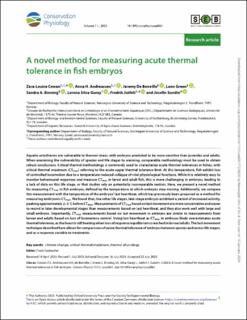| dc.description.abstract | Aquatic ectotherms are vulnerable to thermal stress, with embryos predicted to be more sensitive than juveniles and adults. When examining the vulnerability of species and life stages to warming, comparable methodology must be used to obtain robust conclusions. Critical thermal methodology is commonly used to characterize acute thermal tolerances in fishes, with critical thermal maximum (CTmax) referring to the acute upper thermal tolerance limit. At this temperature, fish exhibit loss of controlled locomotion due to a temperature-induced collapse of vital physiological functions. While it is relatively easy to monitor behavioural responses and measure CTmax in larval and adult fish, this is more challenging in embryos, leading to a lack of data on this life stage, or that studies rely on potentially incomparable metrics. Here, we present a novel method for measuring CTmax in fish embryos, defined by the temperature at which embryos stop moving. Additionally, we compare this measurement with the temperature of the embryos’ last heartbeat, which has previously been proposed as a method for measuring embryonic CTmax. We found that, like other life stages, late-stage embryos exhibited a period of increased activity, peaking approximately 2–3°C before CTmax. Measurements of CTmax based on last movement are more conservative and easier to record in later developmental stages than measurements based on last heartbeat, and they also work well with large and small embryos. Importantly, CTmax measurements based on last movement in embryos are similar to measurements from larvae and adults based on loss of locomotory control. Using last heartbeat as CTmax in embryos likely overestimates acute thermal tolerance, as the heart is still beating when loss of response/equilibrium is reached in larvae/adults. The last movement technique described here allows for comparisons of acute thermal tolerance of embryos between species and across life stages, and as a response variable to treatments. | en_US |

